Update
Unprecedented Rates of Mountain Glacier Melting | Glaciers and the Role of Geneva
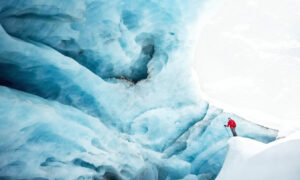
Last updated: 22 Apr 2024
Climate change is causing significant mass loss of high mountain glaciers worldwide. Although glacial systems are highly complex and gaps remain in the understanding of cause-and-effect processes driving the glacial impacts of climate change, clear overall trends indicate a global retreat of glaciers that is expected to accelerate in the coming years and decades.
Ambition to Halt Glaciers Retreat
During its visit to the Everest region in Nepal, United Nations Secretary-General António Guterres called on the world to “stop the madness” of climate change, warning that the “disappearance of glaciers altogether” looms even larger.
Ice Loss Due to Climate Change
Ice mass covers 10% of the Earth land surface (Antarctic ice sheet 8.3%, Greenland ice sheet 1.2%, glaciers and ice caps 0.5%), and its loss is a primary marker of climate change. The decrease has accelerated in recent decades and is now reaching concerning levels. As highlighted by the Intergovernmental Panel on Climate Change (IPCC) in its Working Group I contribution to the Sixth Assessment Report Climate Change 2021: The Physical Science Basis, the widespread retreat of glaciers since 1950 has not been seen in at least 2000 years.
- Recent projection show that mountain glaciers will lose one quarter to one half of their mass by 2100 for global temperature change scenarios. (Rounce et al., 2023)
- Alpine glaciers are likely to lose 90% of their mass by 2100. (Harry Zekollari et al. 2019)
- A third of glaciers in World Heritage sites are set to disappear by 2050. (UNESCO, 2022)
This glacial melting has potentially dramatic consequences not only from a social and cultural point of view but also because glaciers themselves regulate the climate. As a result, the gradual disappearance of glaciers contributes to rising sea levels and an increased risk of drought in densely populated plains. Glacial melting poses various other natural risks, including falling solid materials or the formation of new bodies of water. Glaciers also serve as accumulators of atmospheric pollution, which is then released when glaciers melt.
 Swiss Ice Cave with unreal structures. © 2020 ExpediTom, Mike K | Cover image : A hiker discovers a huge cave of ice on the Glacier de Zinal, outside the village of Zinal, Switzerland © 2020 ALPSINSIGHT
Swiss Ice Cave with unreal structures. © 2020 ExpediTom, Mike K | Cover image : A hiker discovers a huge cave of ice on the Glacier de Zinal, outside the village of Zinal, Switzerland © 2020 ALPSINSIGHT
The Cross-Chapter Paper 5: Mountains — featured in the IPCC Working Group II contribution to the Sixth Assessment Report Climate Change 2022: Impacts, Adaptation and Vulnerability — was first approved by the Panel on 28 February 2022 and published in its final version in August 2022. This research shows that the pace of glacial retreat is significantly faster than what had been stated in the 2019 IPCC Special Report on the Ocean and Cryosphere in a Changing Climate. The IPCC now states with high confidence that many small low-elevation glaciers worldwide will lose more than half their mass even at 1.5°C of warming. The IPCC projections are sufficiently strong to state with medium confidence that low-emission scenarios would preserve around half the current ice mass in low and mid-latitude mountains.
The climate system, the cryosphere, and the hydrological system are deeply intertwined. For example, changes in air temperature cause glaciers to melt, directly affecting streamflow during the summer months. In addition, the related consequences for the ecosystem and human society
Risks in mountain regions are expected to further increase over the course of this century with accelerated climate change negatively affecting biodiversity, ecosystem services and human well-being. Many mountain regions have already witnessed radical glacier loss with many low elevation and small glaciers around the world – including all of Africa’s remaining glaciers – at risk of disappearing within this century.
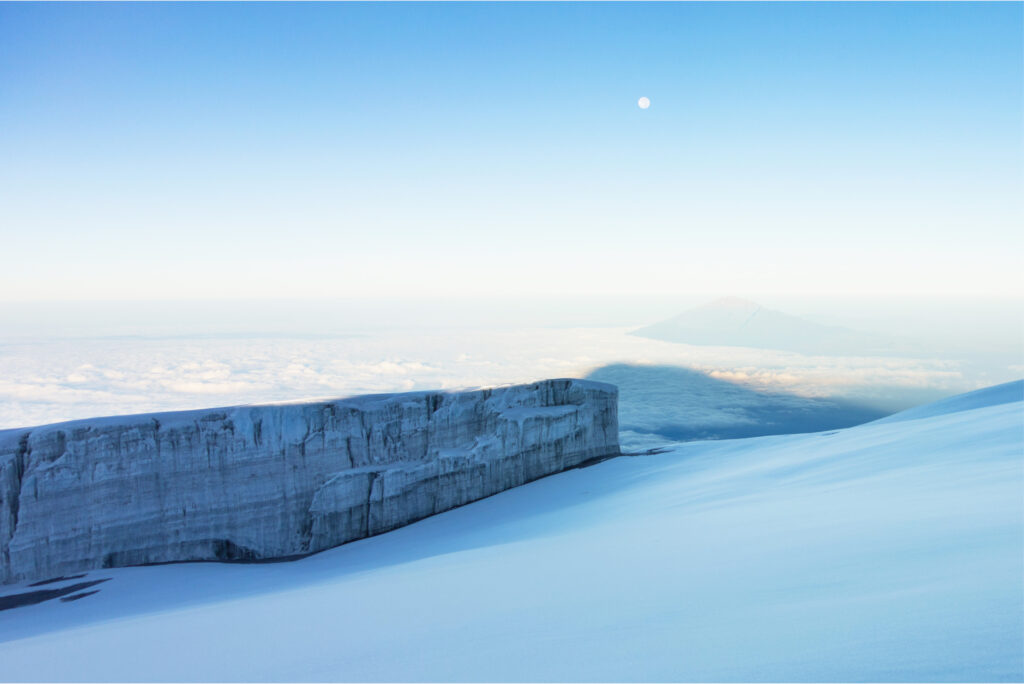 Kilimanjaro’s glaciers are quickly melting due to changes in weather conditions such as humidity and warmer air.
Kilimanjaro’s glaciers are quickly melting due to changes in weather conditions such as humidity and warmer air.
Status of Glaciers in 2023

Climate Tipping Points
The 2019 IPCC Special Report on the Ocean and Cryosphere in a Changing Climate defines a tipping point as:
A level of change in system properties beyond which a system reorganises, often in a non-linear manner, and does not return to the initial state even if the drivers of the change are abated. For the climate system, the term refers to a critical threshold at which global or regional climate changes from one stable state to another stable state.
According to the 2019 UNEP study Temperature rise is ‘locked-in’ for the coming decades in the Arctic, the tipping point has already been reached. As a result of melting permafrost, methane (and other short-lived climate pollutants) could be released faster than expected. An albedo-positive ice shield has been lost, resulting in a powerful feedback loop pushing temperatures ever higher. The accelerating climate instability in the polar region is likely to affect the global climate, exceeding previous predictions of when the global tilt will occur.
Armstrong McKay et al. published in Science, in September 2022, an updated assessment of the most important climate tipping elements and their potential tipping points – 16 identified, including their temperature thresholds, time scales, and impacts. Their analysis indicates that at 1.5°C of heating, the minimum rise now expected, four of the five tipping points move from being possible to likely, and an additional five tipping points become possible, including the loss of almost all mountain glaciers.
The government of Switzerland is proposing to the IPCC to elaborate a Special Report on “Climate Tipping Points and their Implications for Habitability and Resources”, to be prepared in the framework of the IPCC’s 7th Assessment Cycle, scheduled to start in 2023. All three IPCC Working Groups are expected to contribute to this Special Report, making it a comprehensive assessment of the topic. The timing of the approval of the report should take place around 2026 in order to serve as the basis for the second UNFCCC Global Stocktake from 2026 to 2028, and well before the second commitment period under the Paris Agreement in 2030.
Legal Concerns
The high human and environmental stakes in this emerging situation require targeted policy and a geopolitics of ice. Indeed, this environmental issue is directly linked to human rights. The UN has regularly sounded the alarm about melting ice, and national initiatives have begun to protect existing glacial ice.
The current challenge is integrating glacier protection into the transnational environmental law framework. Regional definitions concerning the legal status of mountain glaciers have been developed over time. From a state perspective — for example, in Italy or in certain Latin American States — glaciers are essentially thought of in continuity with the watercourses that follow them. In Switzerland, the preamble to the Protocol on Nature Protection and Landscape Conservation of the Alpine Convention recognizes the exceptional importance of glaciers.
Cryosphere Services and the SDGs
Moreover, the cryosphere and mountain glaciers provide many ecological benefits related to the UN Sustainable Development Goals (SDGs). Societies can benefit from so-called cryosphere services by provisioning, regulating, cultivating, reflecting, and supporting basic human needs, ecological conservation, and economic development. According to the Cryosphere Services to Support SDGs in High Mountains report, pathways to achieve the 2030 SDG agenda in high mountains must consider trade-offs and synergies among cryosphere services. These strategies must be established through combined efforts in governance and financing, individual and collective actions, science, and technology.
IPCC definition of the cryosphere :
The components of the Earth System at and below the land and ocean surface that are frozen, including snow cover, glaciers, ice sheets, ice shelves, icebergs, sea ice, lake ice, river ice, permafrost and seasonally frozen ground. See also Climate system.
Glacial Impacts in Switzerland
Glaciers in Switzerland lost half their volume between 1931 and 2016 and another 12% between 2016 and 2021. This ice loss was described in a study published in the scientific journal The Cryosphere in August 2022 by a team of researchers from ETH Zurich and the Swiss Federal Institute for Forest, Snow and Landscape Research (WSL). The World Meteorological Organization 2022 State of Climate Report, signals that between 2021 and 2022, an additional 6% of glacier ice volume was lost.
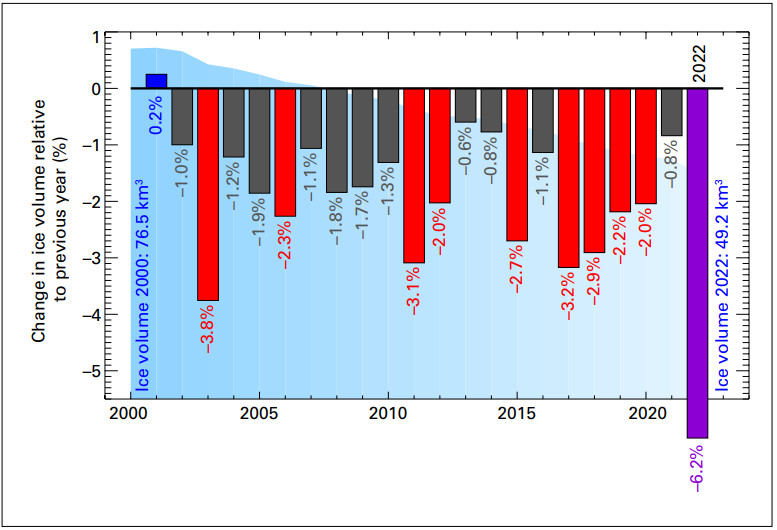
Total annual loss 2022 of Swiss glaciers related to the current ice volume 2002–2022. The vertical bars indicate the percentage change in ice volume relative to the previous year. Red and purple bars are the 10 largest relative mass losses on record. The purple bar is the relative mass loss for 2022. The blue-shaded area in the background represents the overall ice volume. Source: Matthias Huss based on Glacier Monitoring Switzerland, 2022: Swiss Glacier Mass Balance (2022).
The summer of 2023 continues to be on track for the second-most negative year in history of Swiss glaciers retreat, with glaciers clearly below the average of the last 10 years. With 4% of ice volume destroyed in 2023, the Swiss Commission for Cryosphere Observation of the Swiss Academy of Sciences reported that a total of 10% of the ice volume disappeared in only two years.
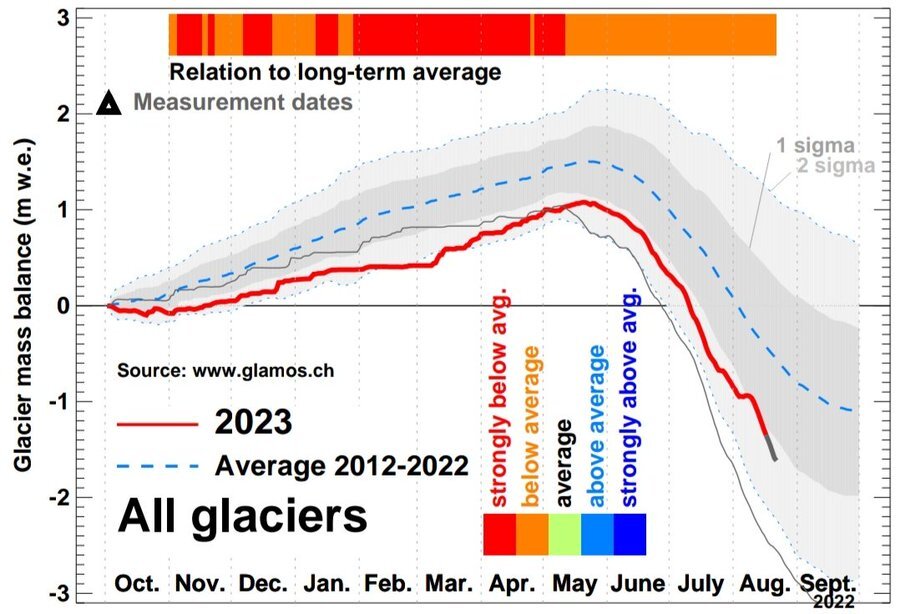
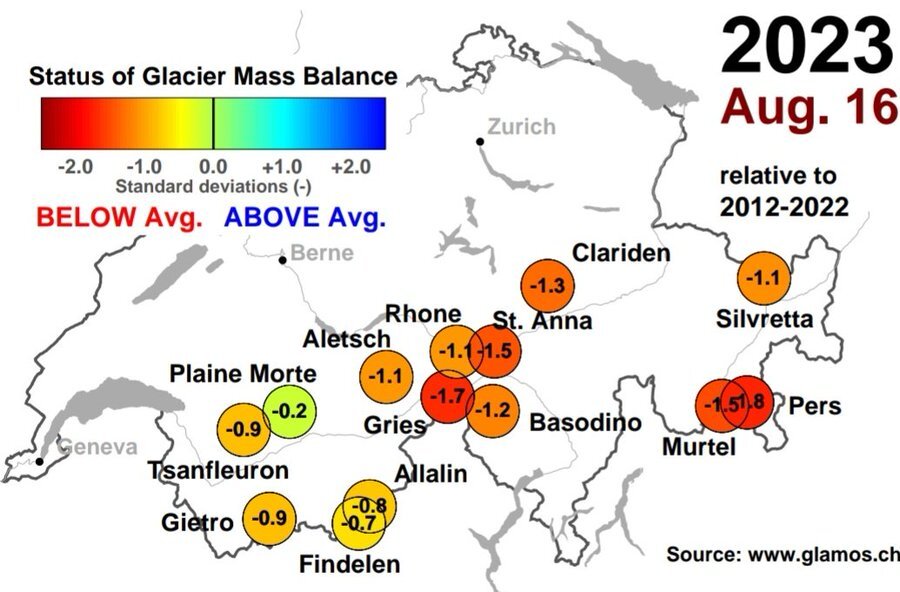
Source: GLAMOS – Glacier Monitoring in Switzerland
The climate system, the cryosphere, and the hydrological system are deeply intertwined. For example, changes in air temperature cause glaciers to melt, directly affecting streamflow during the summer months. In addition, the related consequences for the ecosystem and human society.
Impacts
Landscape and surface processes
Rapid glacier shrinkage is among the most obvious and visible phenomena related to ongoing warming trends. Entire ecosystems as well as their individual parts have strongly different characteristics and time scales of response to fast climate change. This will undoubtedly lead to growing distances from conditions of dynamic equilibrium. A recent study published in the journal Nature showed how “[…]by 2100, the decline of all glaciers outside the Antarctic and Greenland ice sheets may produce new terrestrial, marine and freshwater ecosystems over an area ranging from the size of Nepal (149,000 ± 55,000 km2) to that of Finland (339,000 ± 99,000 km2)”. According to the researchers, “in deglaciated areas, the emerging ecosystems will be characterized by extreme to mild ecological conditions, offering refuge for cold-adapted species or favouring primary productivity and generalist species.”
Natural hazards
Most critical stability conditions in perennially frozen rock walls are expected to be found in areas with warm permafrost. Deep long-term warming of perennially frozen mountain peaks has the potential to bring steeply inclined rock layers to critical temperatures, not only over more extended vertical ranges but also to greater depths. As a consequence, the probability of large rock falls is slowly increasing. The possibility of flood waves from impacts of large rock, ice, snow or mixed avalanches must, therefore, be seriously considered.
 Swiss glaciers and permafrost map © 2022 UNEP/GEN Marina Garlatti
Swiss glaciers and permafrost map © 2022 UNEP/GEN Marina Garlatti
Water cycle
As a result of climate change, the maximum in river discharge will occur earlier in the year and will be less pronounced. The combined effect of increased precipitation will lead to a growing risk of winter flooding in lowlands surrounding the Alps. Drier summers, on the other hand, will lead to more frequent and severe droughts. Despite the large water resources in the Alpine region, water stress could become a problem in some parts of Switzerland and due to the increasing demands for domestic freshwater supply, agriculture, hydropower production, etc. Conflicts about water use are likely to grow and options for adaptation should be investigated as early as possible.
International Cooperation
International Year of Glaciers’ Preservation
At the 77th regular session of the UN General Assembly, the General Assembly decided to declare 2025 the International Year of Glaciers’ Preservation and to proclaim 21 March of each year the World Day for Glaciers, to be observed starting in 2025. Recognizing that, in many high mountain areas, glacier retreat and permafrost thaw are projected to further decrease the stability of slopes, and that the incidences of floods owing to glacier lake outburst or rain-on-snow, landslides and snow avalanches are projected to increase and occur in new locations or different seasons, the observations aim at boosting the creation of a worldwide inventory of existing perennial ice and snow masses.
Glacier Monitoring
Worldwide collection of information about ongoing glacier changes started in August 1894, with the foundation of the International Glacier Commission at the 6th International Geological Congress, in Zurich.
The Second World Climate Conference in 1990 called for the urgent establishment of a coordinated climate monitoring system. As a consequence, the Global Climate Observing System (GCOS) and the Global Terrestrial Observing System (GTOS) were established in 1992 and 1996, respectively, under the auspices of FAO, ICSU, UNEP, UNESCO, and WMO. Within GCOS/GTOS the Terrestrial Observation Panel for Climate (TOPC) was created to design a global observing strategy and set in place a Global Terrestrial Network (GTN) for all Essential Climate Variables (ECV) in the terrestrial domain in support of the United Nations Framework Convention on Climate Change (UNFCCC).
Today, glacier monitoring is coordinated within the framework of the Global Terrestrial Network for Glaciers (GTN-G), a worldwide collaboration network in more than 40 countries run by the World Glacier Monitoring Service (WGMS), the US National Snow and Ice Data Center (NSIDC), and the Global Land Ice Measurements from Space (GLIMS) initiative.
High Mountain Summit
The WMO High Mountain Summit, held in Geneva in October 2019, concluded with a Call to Action and a roadmap of priority activities. The priority actions aim to support more sustainable development, disaster risk reduction and climate change adaptation.
The summit highlighted that Earth system processes over complex mountain terrain are insufficiently observed and understood to confidently model their behaviour. Consequently, the resulting impacts of those changes on people and economies have not been well-articulated in major international policy frameworks such as the Sendai Framework for Disaster Risk Reduction or the Paris Agreement on Climate Change. As water security is becoming one of the greatest challenges for humanity, and a source of political tension within and between nations, the absence of such references makes the task of developing and implementing relevant policies much more difficult.
The findings of the IPCC Special Report on the Ocean and Cryosphere in a Changing Climate dedicated chapter on high mountain areas convey a sense of urgency in addressing the hydro-climatic changes in high mountains, their impacts and their downstream effects.
Mountain Adaptation Programs
UNEP aims to tackle the climate crisis and – in line with the UN Decade on Ecosystem Restoration – prevent, halt and reverse the degradation of mountain ecosystems, and support the achievement of Sustainable Development Goal 15. Under the Adaptation at Altitude programme, financed by the Swiss Agency for Development and Cooperation (SDC), partners, including UNEP have identified innovative mountain adaptation solutions around the globe and bring together policy representatives from mountainous countries to share plans for improving the resilience of people upstream and downstream.
In support of the International Year of Sustainable Mountain Development 2022, more global efforts are needed to build resilient mountain communities and foster sustainable mountain development. With global warming above 1.5 °C, the need for adaptation in mountains becomes a key priority (IPCC 2022). Besides the Adaptation Gap Report, which urgently calls for climate adaptation planning, finance and implementation to be stepped up, UNEP published two booklets on concrete and innovative mountain adaptation solutions in East Africa and the South Caucasus, as part of the Adaptation at Altitude programme.
One Planet – Polar Summit 2023
On 10 November during the One Planet – Polar Summit, as part of the Paris Peace Forum, at the initiative of the President of the French Republic, Emmanuel Macron, and in partnership with WMO and UNESCO a joint Paris Call for Glaciers and Poles – Declaration for the One Planet – Polar Summit was launched. The summit called for urgent action to cut greenhouse gas emissions, for more in-depth scientific research on the cryosphere, and for better integration of the effects of the retreat of the cryosphere into policy-making. The declaration pledged support for a United Nations Decade on Polar and Glacier Sciences, to start in 2025 – which is the International Year of Glaciers’ Preservation – and feed into the Fifth International Polar Year in 2032-33. On the occasion of the One Planet Polar Summit, France and Netherlands joined with other countries the ‘Ambition on Melting Ice (AMI) high-level group: on Sea-level Rise and Mountain Water Resources’, launched November 16, 2022. → Read the Recommendations of Civil Society Organizations on the Occasion of the One Planet – Polar Summit 2023.
The Role of Geneva
Climate change is deeply linked to biodiversity loss, human rights, economic prosperity, trade, health, and many other issues at the heart of multilateral processes in Geneva. These multilateral processes can be used to foster international cooperation on glacier loss, as highlighted in the examples below.
Organizations are listed in alphabetical order.
Adaptation at Altitude Programme
The Adaptation at Altitude is a collaborative programme launched and co-supported by the Swiss Agency for Development and Cooperation (SDC). The programme aims to increase the resilience and adaptive capacity of mountain communities and ecosystems.
It seeks to foster exchange of such information among the mountain areas of the world to help in the search for short-and long-term solutions to the problems arising from climate change.
Geneva Climate Change Consultation Group (GeCCo)
GeCCco gathers civil society organizations working in Geneva to bring forward the human rights issues raised by climate change and to introduce these climate change issues in the work of the Geneva-based UN Human Rights Bodies. The GeCCco also keeps a close eye on the UNFCCC processes thanks to the NGO Working Group on Human Rights and Climate Change, the oldest and main coalition on this matter, to which a number of the participating organizations are also member.
Group on Earth Observations (GEO)
Earth observations relevant to climate action are not limited to weather or climate, but are much broader and include terrestrial and socio-economic variables.GEO makes available Earth observations in support of effective policy responses for climate change adaptation, mitigation and other specific provisions, working with partners to enhance global observation systems for climate action. GEO will be present at COP26 with a series of events to promote the role of Earth observations in providing actionable information for climate adaptation and mitigation.
Intergovernmental Panel on Climate Change (IPCC)
The IPCC was set up to provide an objective source of scientific information. In 2013, the IPCC provided more clarity about the role of human activities in climate change when it released its Fifth Assessment Report. The IPCC also published the Cryosphere Services to Support SDGs in High Mountains report, which indicates trade-offs and synergies must be considered to achieve the 2030 SDG agenda in high mountains.
International Glacier Film Festival
The International Film Festival on Glaciers (FIFG) is an opportunity to sound the alarm on the deadly consequences of global warming. The 6th International Film Festival on Glaciers will focus on the adaptability of cities to global warming.
International Union for Conservation of Nature (IUCN)
The IUCN assesses the impacts of climate change on species and ecosystems. Through its work on ecosystem-based mitigation, adaptation and disaster risk reduction, it also highlights the important role of nature-based solutions to climate change. It also works to ensure that climate policy and action are gender-responsive, socially inclusive and take into account to the needs of the most vulnerable.
Office of the United Nations High Commissioner on Human Rights (OHCHR)
As climate change threatens the effective enjoyment of a range of human rights, the OHCHR aims to ensure that environmental and climate policies and plans are implemented in accordance with international human rights standards. To help States, businesses and other duty-bearers meet this expectation, OHCHR’s Key Messages on Human Rights and Climate Change, outline key human rights obligations in the context of climate change. Since 2015, OHCHR has also organized annual Human Rights Council (HRC) panel discussions and produced analytical studies on various subjects on climate change and human rights.
SDC – Swiss Agency for Development and Cooperation
The Swiss Agency for Development and Cooperation’s activities fall under the Blue Peace initiative. This was co-initiated by Switzerland and advocates peaceful water management in various regions of the world. In Central Asia the SDC can benefit from a wide network of international and regional partners who are also active in the water sector.
Swiss Federal Office for the Environment (FOEN)
Switzerland’s glaciers are monitored in a systematic manner by the scientific community and the government, who signed an agreement governing the glacier monitoring. As a result, 105 glaciers will be monitored in the long term. The related data for the fields of climate, water, natural hazards and the environment will be made available to a wide audience on an internet platform. The glaciers have been melting for decades due to climate warming, therefore their monitoring is very important.
The Geneva Cryosphere Hub
The Geneva Cryosphere Hub is the link between Switzerland and the pavilion which will be dedicated to the cryosphere at the 26th Conference of the Parties (COP26) in Glasgow from November 1–12, 2021.
The Hub aims at raising awareness about the critical role played by the Cryosphere, to discuss latest scientific evidence on cryosphere processes and, ultimately, at contributing to enhancing the ambition level to achieve tangible outcomes at COP26.
UNEP/GRID-Geneva
The Global Resource Information Database – Geneva (GRID-Geneva), is a partnership between the United Nations Environment Programme (UNEP), the Swiss Federal Office for the Environment (FOEN) and the University of Geneva (UniGe). With a team of 20 Environment Data Scientist, GRID-Geneva main role is to transform data into information and knowledge to support the decision making process related to environmental issues. Glaciers are a critical component of the earth system. An environmental report published by GRID shows how glaciers are retreating and melting faster than they should.
United Nations Economic Commission for Europe (UNECE)
The UNECE region is a major source of greenhouse gas emissions, responsible for 34% of the world’s CO2 emissions from fossil fuel combustion. The people of the region are increasingly feeling the impacts of climate change – from wildfires to flooding, heatwaves and drought. Through its norms, standards, conventions and policy assistance, UNECE provides key tools supporting countries in their climate change mitigation and adaptation efforts.
United Nations Environment Programme (UNEP)
The work of UNEP on climate action cuts across the fields of science, policy, technology and finance. It empowers countries to pursue low-emission development and boost their capacity to adapt and be resilient to climate heating. UNEP is also working to implement the Paris Agreement and its contributions include bringing science to policymakers, playing a leading role in transformative global partnerships, and helping dozens of countries develop national plans to cut greenhouse gas emissions. In addition, UNEP equips countries to seize new investment opportunities that reduce greenhouse gas emissions from deforestation and forest degradation and supports the development of new finance models to accelerate the transition to a green economy. Through the Climate Finance Unit, UNEP also focuses on supporting developing countries to access climate finance (directly and through accredited entities) from the Green Climate Fund (GCF), the Global Environment Facility (GEF), and the Adaptation Fund (AF) as well as through other bilateral or multilateral public sources.
University of Geneva
The UNIGE is involved in glachiers and mountain research as the Department F.-A. Forel for environmental and aquatic sciences. A Research at UNIGE focuses on melting glaciers in Central Asia as well as water resources
World Economic Forum (WEF)
The WEF Climate Change Intelligence is a visual representation of climate change and provides an overview and the key trends affecting it, along with summaries and links to the latest research and analysis on each of the trends.
World Meteorological Organization (WMO)
The WMO helps its members to monitor the Earth’s climate on a global scale so that reliable information is available to support evidence-based decision-making on how to best adapt to a changing climate and manage risks associated with climate variability and extremes.
WMO supports events such as the First World Virtual High Mountain Summit, which brought together more than 50 participants to discuss biodiversity and ecosystem services as well as climate variability.
WWF
WWF works to tackle the climate crisis in a variety of ways. From encouraging governments to implement more ambitious climate policies, to supporting the shift to renewable energy, to working with cities, businesses and communities to create a climate-resilient, net-zero future. WWF is involved in Global warming and impact mountain areas in a particularly severe way, posing a very serious threat to Alpine nature.
Zoï Environment Network
Zoï Environment Network is a non-profit environmental organization driven by our belief that access to information lies at the heart of democracy and plays a prominent role in the quest to build sustainable societies. The team also works to enable dialogue, develop skills and build capacity in government, academia and civil society.
Several international actors are involved in the fight against climate change in Geneva.
Learning
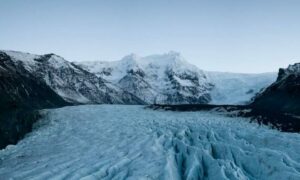
Environmental Governance & Policy-Making
IHEID | 14 October 2021
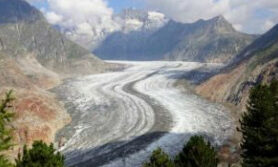
MOOC | Climate and Water in Mountains | A Global Concern
UNIGE | Online
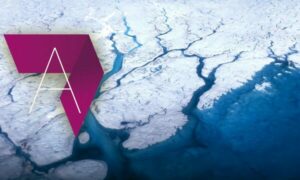
MOOC | Global Artic
EPFL | Online
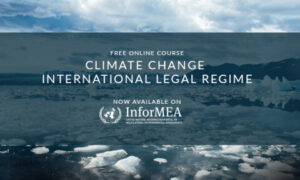
Climate Change International Legal Regime
InforMEA | Online
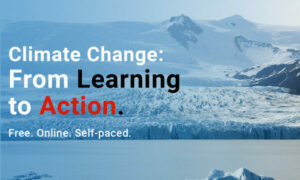
Climate Change: From Learning to Action
UN CC:Learn | Online
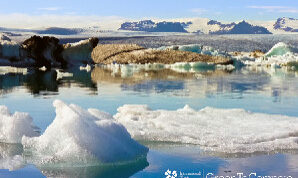
Becoming a Climate Resilient SME
ITC | 31 October 2022 | Online
Latest News
- Ubiquitous acceleration in Greenland Ice Sheet calving from 1985 to 2022 | Chad A. Greene, Alex S. Gardner, Michael Wood & Joshua K. Cuzzone | Nature | 17 January 2024
- The Exploradores glacier, in Chile, closed due to ice sheet conditions | Copernicus EU | 13 November 2023
- One Planet-Polar summit calls for action on the cryosphere | WMO | 10 November 2023
- I’m saving a glacier (by putting it in my freezer) | The Times | 9 August 2023
- Polar scientists call for urgent action in view of rapid Arctic and Antarctic change | WMO | 16 June 2023
- Global glacier change in the 21st century: Every increase in temperature matters | Rounce et al. | Science, 379, 78-83 | 5 January 2023
- UNESCO finds that some iconic World Heritage glaciers will disappear by 2050 | UNESCO | 3 November 2022
- Worse than 2003: Swiss glaciers are melting more than ever before | SCNAT | 28 September 2022
- Modelling the future evolution of glaciers in the European Alps under the EURO-CORDEX RCM ensemble | The Cryosphere | 13 September 2022
- Pakistan: 2022 Monsoon Floods | ReliefWeb | 26 August 2022
- Cryosphere Services to Support SDGs in High Mountains | Sustainability | 11 January 2022
- A historical perspective on glacial retreat | ETHZ | 22 August 2022
Reports
- State of Global Water Resources 2022 | World Meteorological Organization | 12 October 2023
- State of the Climate in Europe 2022 | World Meteorological Organization | 21 June 2023
- State of the Global Climate in 2022 | World Meteorological Organization | 21 April 2023
- AR6 Synthesis Report: Climate Change 2023 | IPCC | 20 March 2023
- The State of the Cryosphere report | International Cryosphere Climate Initiative | 7 November 2022
The report details how a combination of melting polar ice sheets, vanishing glaciers, and thawing permafrost will have rapid, irreversible, and disastrous effects on the Earth’s population. - World heritage glaciers: sentinels of climate change | UNESCO & IUCN | 3 November 2022
- Working Group II Sixth Assessment Report Climate Change 2022: Impacts, Adaptation and Vulnerability | IPCC | 28 February 2022
- Special Report on the Ocean and Cryosphere in a Changing Climate | IPCC | 25 September 2019
- Global glacier changes: facts and figures | UNEP | 2008
- Global outlook for ice and snow | UNEP 2007
- Glaciers and the Environment | UNEP | 1992
GEN Events
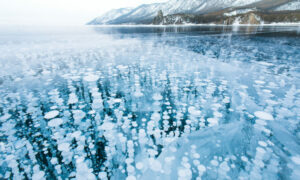
Climate Tipping Points, Irreversibility and their Consequences for Society, Environment and Economies
Switzerland’s Proposal for an IPCC Special Report, Geneva Environment Network | 25 May 2022

Leveraging Glasgow’s Ambition in Geneva’s Multilateral Processes
Geneva Chryosphere Hub, University of Geneva | 12 Nov 2021
